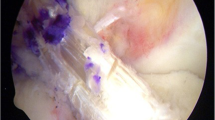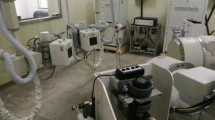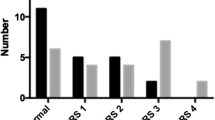Abstract
Objective
The purpose of this study is to evaluate the difference of patellofemoral kinematics between weightbearing and non-weightbearing conditions in the arthrofibrotic knee after anterior cruciate ligament (ACL) reconstruction.
Methods
Twenty patients with arthrofibrosis after ACL reconstruction were included in the study. Computed tomography scanner and dual fluoroscopic imaging techniques were used to compare patellofemoral kinematics of the affected knee between weightbearing knee flexion and non-weightbearing knee flexion. In both positions, patellofemoral kinematics in six degrees-of-freedom (6 DOF) were measured respectively.
Results
The patellar lateral tilt angle (p = 0.007) and medial patellar translation (p = 0.043) under the weightbearing condition were significantly decreased compared to the non-weightbearing task between 5° and 15° of knee flexion. The lateral patellar translation during a non-weightbearing task was significantly decreased between 60° and 75° of knee flexion (p = 0.005), and the inferior patellar translation under the weightbearing condition was significantly increased between 45° and 75° of knee flexion (p = 0.040).
Conclusion
These results indicate that patellofemoral kinematics during non-weightbearing positions do not sufficiently represent the patellar tracking during functional weightbearing activities. Our findings of this study establish the clinical relevance and significance of assessing the patellofemoral kinematics under the weightbearing condition when evaluating patients with arthrofibrosis after ACL reconstruction.
Trial registration
Trial registration number: ChiCTR1900025977.



Similar content being viewed by others

Availability of data and material
Data are available on reasonable request.
Code availability
Not applicable.
References
Fu FH (2019) Loss of motion after anterior cruciate ligament reconstruction. Am J Sports Med 20:499–506
Calloway SP, Soppe CJ, Mandelbaum BR (2018) Clinical outcomes after arthroscopic release of patellofemoral arthrofibrosis in patients with prior anterior cruciate ligament reconstruction. J Arthroscopy 34:4969–4974
Mikula JD, Slette EL, Dahl KD (2017) Intraarticular arthrofibrosis of the knee alters patellofemoral contact biomechanics. J Exp Orthop 4:40
FlyRen M, Davis J, Peterson MGE (2007) A mini-midvastus capsular approach with patellar displacement decreases the prevalence of patella baja. J Arthroplasty 22:50–57
Giori NJ, Giori KL, Woolson ST (2001) Measurement of perioperative flexion-extension mechanics of the knee joint. J Arthroplasty 16:877–881
Ekhtiari S, Horner NS, De Sa D (2017) Arthrofibrosis after ACL reconstruction is best treated in a step-wise approach with early recognition and intervention: a systematic review. Knee Surg Sports Traum A 456:346–350
Nakamae A, Ochi M, Deie M (2014) Clinical outcomes of second-look arthroscopic evaluation after anterior cruciate ligament augmentation: comparison with single- and double-bundle reconstruction. Bone Joint J 67:236–242
Esfandiarpour F, Lebrun C, Dhillon S, Boulanger P (2018) In-vivo patellar tracking in individuals with patellofemoral pain and healthy individuals. J Orthop Res 4:132–138
Kim TH, Sobti A, Lee SH (2014) The effects of weight-bearing conditions on patellofemoral indices in individuals without and with patellofemoral pain syndrome. Skelet Radiol 43:157–164
Brossmann J, Muhle C, Schröder C, Melchert U, Büll C, Spielmann R (1993) Patellar tracking patterns during active and passive knee extension: evaluation with motion-triggered cine MR imaging. Radiology 187:205–212
McWalter EJ, Hunter DJ, Wilson DR (2010) The effect of load magnitude on three-dimensional patellar kinematics in vivo. J Biomech 43:1890–1897
Kalson DN, Borthwick DL, Mann D (2016) International consensus on the definition and classification of fibrosis of the knee joint. J Arthrosc 98:1479
Li G, Samuel K, Van de V (2008) Validation of a non-invasive fluoroscopic imaging technique for the measurement of dynamic knee joint motion. J Biomech 34:402–407
Van de Velde S, Gill T, DeFrate L (2008) The effect of anterior cruciate ligament deficiency and reconstruction on the patellofemoral joint. Am J Sports Med 36:1150–1159
Thomeer L, Guan S, Gray H (2020) Six-degree-of-freedom tibiofemoral and patellofemoral joint motion during activities of daily living. Ann Biomed Eng 43:1347–1352
Mayr H, Weig T, Plitz W (2004) Arthrofibrosis following ACL reconstruction–reasons and outcome. arch. orthop. Trauma Surg 124:518–522
Mayr H, Brandt C, Weig T (2017) Long-term results of arthroscopic arthrolysis for arthrofibrosis after anterior cruciate ligament reconstruction. J Arthrosc 33:408–414
Shellock FG, Mink JH, Deutsch AL (1993) Patellofemoral joint: identification of abnormalities with active- movement, ‘unloaded’ versus ‘loaded’ kinematic mr imaging techniques. Radiology 188:575–578
Stensdotter A, Hodges P, Mellor R (2003) Quadriceps activation in closed and in open kinetic chain exercise. Med Sci Sport Exer 35:2043–2047
Brossmann J, Muhle C, Schröder C, Melchert UH, Büll CC, Spielmann RP (1993) Patellar tracking patterns during active and passive knee extension: evaluation with motion-triggered cine MR imaging. Radiology 187:205–212
Song CY, Lin JJ, Jan MH (2011) The role of patellar alignment and tracking in vivo: the potential mechanism of patellofemoral pain syndrome. Phys Ther Sport 2:326–330
Christine E, Draper F, Besier G (2010) Differences in patellofemoral kinematics between weight-bearing and non-weight-bearing conditions in patients with patellofemoral pain. J Orthop Res 43:65–70
Cohen ZA, Roglic H, Grelsamer RP (2001) Patellofemoral stresses during open and closed kinetic chain exercises. An analysis using computer simulation. Am J Sport Med 29:480–487
Powers CM, Ward SR, Fredericson M (2003) Patellofemoral kinematics during weight-bearing and non-weight-bearing knee extension in persons with lateral subluxation of the patella: a preliminary study. J Orthop Sports Phys Ther 33:677–685
Kim T, Sobti A, Lee S, Lee J, Oh K (2017) The effects of weight-bearing conditions on patellofemoral indices in individuals without and with patellofemoral pain syndrome. Skelet Radiol 43:157–164
Evrard L, Audigié F, Bertoni L (2019) Low field magnetic resonance imaging of the equine distal interphalangeal joint: comparison between weight-bearing and non-weight-bearing conditions. PLoS ONE 43:157–164
MacIntyre NJ (2006) Patellofemoral joint kinematics in individuals with and without patellofemoral pain syndrome. J Bone Joint Surg Am 88:2596–2605
Fellows RA, Hill NA, Gill HS (2005) Magnetic resonance imaging for in vivo assessment of three-dimensional patellar tracking. J Biomech 38:1643–1652
Acknowledgements
This manuscript has been edited for English language by professional editors at Editage, a division of Cactus Communications.
Funding
This study is supported by the (China) State’s Key Project of Research and Development Plan [grant numbers 2018YFF 0300504].
Author information
Authors and Affiliations
Contributions
(I) Conception and design: B Cai; (II) administrative support: SB Wang, S Fan; (III) provision of study materials or patients: L Zhang, S Fan; (IV) collection and assembly of data: L Zhang, JL Ye; (V) data analysis and interpretation: L Zhang, SB Wang; (VI) manuscript writing: all authors; (VII) final approval of manuscript: all authors.
Corresponding author
Ethics declarations
Ethics approval
The authors are accountable for all aspects of the work in ensuring that questions related to the accuracy or integrity of any part of the work are appropriately investigated and resolved. This study was performed in accordance with the guidelines outlined in the Declaration of Helsinki (as revised in 2013) and approved by the Ethics Committee of Ninth People’s Hospital, Shanghai Jiao Tong University School of Medicine, Shanghai, China (reference number: SH9H-2019-T220-1). Informed consent was obtained from each patient before taking part.
Consent to participate
Paper submitted with consent participation of patients.
Consent for publication
Paper submitted for publication with consent knowledge of co-authors.
Conflict of interest
The authors declare no competing interests.
Additional information
Publisher's Note
Springer Nature remains neutral with regard to jurisdictional claims in published maps and institutional affiliations.
Reporting checklist
The authors have completed the STROBE checklist.
Rights and permissions
About this article
Cite this article
Zhang, L., Wang, Sb., Fan, S. et al. Differences in patellofemoral kinematics between weightbearing and non-weightbearing conditions in patients with arthrofibrosis after anterior cruciate ligament reconstruction. International Orthopaedics (SICOT) 46, 837–843 (2022). https://doi.org/10.1007/s00264-022-05302-7
Received:
Accepted:
Published:
Issue Date:
DOI: https://doi.org/10.1007/s00264-022-05302-7



